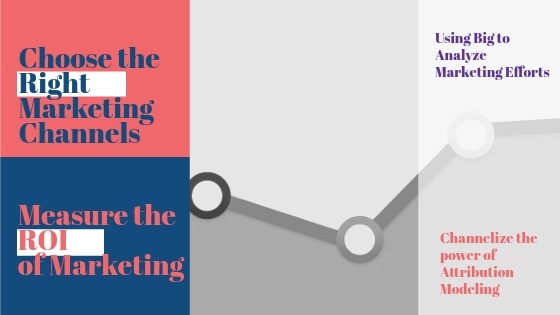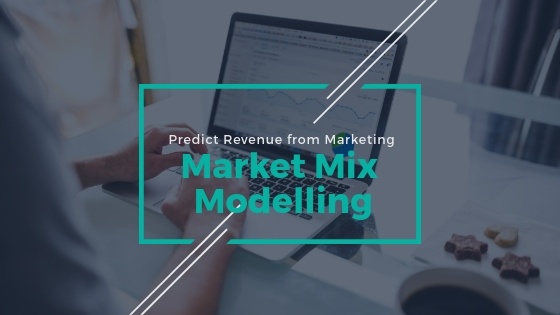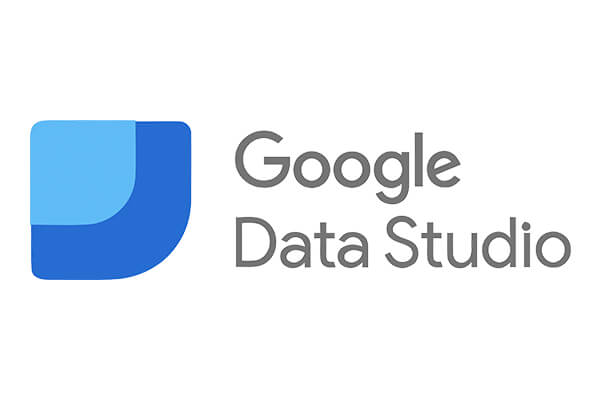5 Practical Uses of Big Data in Marketing and Sales
Big data analysis is a powerful tool at the disposal of marketers. With the technology advancing rapidly, it has become a powerful tool for sales and...
6 min read
Sales : Mar 7, 2018 12:00:00 AM

There was a time when pacing an outdoor banner seemed to be the most you do in marketing. Fast-forward to today marketers are analyzing every action of consumers to make the best use of every channel possible. We can now say that big data has become a buzzword in marketing. With this, we can gain insights into the consumer's behavior, target ads around customers journey, optimize funnels, make better use of the budget – and the list of advantages seems never-ending. Marketers across the world are banking on the advantages of data.
Today, 78% of marketers have an embedded or strategic data-driven marketing process. 63% of marketers have also reported that their spending on data-driven marketing grew just over the last year.
There are many distinct ways in which you as a marketer can leverage big data. In this blog, we will understand some uses of big data in marketing along with case studies and insights from experts.
Interested in Big Data? Catch the latest innovations and trends with our eBook:
In marketing, we deal with many distribution and promotion channels at the same time. This makes it difficult to hold anyone channel responsible for a conversion. Before making a purchase, a customer might research online, look up on social media, ask for peer reviews and then finally make a purchase from the store. With big data, it is possible to create attribution models that help identify the contribution of each channel in the final conversion.
.jpg?width=560&name=Attribution-Modeling%20(1).jpg)
Brian Wulfe CEO of Effective Spend - a digital advertising agency, shared some case studies where his company successfully used attribution models. “One campaign that comes to mind is the work with have done for Bellacor (an online retailer with a product catalog of over 750,000 home furnishings). Our agency manages their online advertising in channels like Google and Facebook, and it is imperative that we allocate budget across the entire product catalog to drive the highest ROI. By leveraging specific product attributes, and the demographics of historical purchasers of those products we were able to build out more compelling advertisements and allocate budget more effectively to drive ROI.
Another project we are working on is with a Document Filings client - Swyftfilings, where we are cross-referencing target market demographics such as income, marital status, gender, age, and various other data points to apply budget modifiers for the client’s Google Ads. By analyzing their core customer database, we identify attributes associated with their ideal customer profile. We then take open source Census population data associated to each geography within their target market and use that to customize advertisements, and budget according to the areas which have the highest density populations that meet their ideal customer profile.”
Read More: How to Predict Customer Purchases for Effective Cross-selling?
Programmatic advertising refers to automatically buying digital advertising space, with the help of data to decide the placement and bid, often in real time. Contrary to the traditional approach, programmatic puts the control in the hands of advertisers and not in that of publishers. Programmatic is rapidly picking up as the go-to approach for advertising especially in enterprise companies where budgets and impact of decisions are very dramatic.

Robert Brill CEO of BrillMedia - a hyperlocal marketing agency shared one way where programmatic advertising can help both advertisers and customers. “There are four key connectors in digital advertising: email address, cookie, device ID and social ID. If a company has one it can then connect to the others using an intermediary. So, let’s say we track where people go in the physical world by device ID, which is the unique identifier of each of our phones. The device ID connects to the places we go by collecting latitude and longitude coordinates all the time via apps. Let’s say we track people who walk into Starbucks. We can then track where else they go in the physical world and we can then understand by hour the parts of town that our audience is in. Then we can run out of home ads based on those locations where we know our audience goes by day and night. We can buy individual boards for a month at a time, or we can buy them on an auction if the out of home placement is a screen.
Let’s say you have a list of emails of people who bought from your store. Work with an intermediary to connect those email addresses to a device ID and see where those people go in the physical world and then buy ads in those locations. The same can be done for website visitors. Cookies to device IDs to a map showing where your audience goes in the physical world, followed by an out of home ad campaign.”
Read More: Catering to the Customer Demands in the Age of Millennials
SEO experts (Webmasters) have made great progress in their approach just by analyzing data. Companies like MOZ, SEMRush, Ahrefs all have come from the ground up by strategizing the approach to SEO using data. Today webmasters can get data for almost anything, in fact, Google itself has offered many tools for this purpose. By aggregating the data about keywords with behavioral metrics marketers can understand a lot about user’s intent and impact of minor changes on the rankings.

Syed Irfan, Growth Marketer at Ridester shared the data-backed SEO approach used by their company to get themselves to 350,000 visitors/month. You can also use this strategy to get the best from your SEO efforts. Here is the strategy:
1. We use Google Analytics, Long Tail Pro, SEMrush and Ahrefs etc to find keywords with high search volume. We also use the same tools to find keywords used by our competitors.
2. The detailed analysis is then taken to the next step whereby we shortlist keywords which have a decent search volume but which have low-to-medium range “SEO competition”. Please note that “SEO competition” is not the same as the “advertiser competition” shown by AdWord.
3. Then we use a feature of Ahrefs (a tool already mentioned in #1) called Ahrefs Content Explorer and/or BuzzSumo to find topics related to our client’s industry and the keywords we have had shortlisted which are going viral and are getting lots of social shares and/or lots of backlinks.
4. Then we come up with a few ideas for a power page (a specific type of long-form high-quality in-depth evergreen content) and create that content piece.
5. Then we work on promoting that content piece through email outreach, social outreach. We use a considerable amount of data analysis in this step as well; for instance, we try to find who else has written on a similar topic and which other blogs have given a backlink to those other content pieces. Then we reach out to those same sites to pitch them a guest post or persuade them through other means to link out to our power pages.
Read More: 5 Reasons to Choose Python for Big Data
If you ever worked in an enterprise company you would understand how complicated it gets to bridge the communication gap between different teams, departments, and locations. In industry nomenclature, this is called silos. With Big Data we can break down these barriers to communication and make insights easily accessible throughout the organization.

Sam Underwood, Director Business Strategy at Futurety - a data-intensive marketing agency - shared how their company helps clients use data to break down organization silos. “The greatest advantage to using big data in marketing is breaking down silos between functional marketing teams. Oftentimes, a social media team (for example) may not share learnings with a sales team, or a customer service team with a digital team. Tracking these teams' respective data makes it very efficient to organize observations and learnings, and share them out across the organization. We often do this using cloud-based, customizable dashboards that we create and host for our clients and use as a tool to facilitate strategic discussions for future marketing campaigns. This way, each team can very easily see what worked and what didn't for their counterparts elsewhere in the organization, and incorporate these learnings quickly and efficiently.”
Read More: The 7 Step Big Data Strategy
Major organizations are gathering data on in-video interactions across massive video libraries - analytics that helps move visitors into the funnel and toward conversion, as well as refine video marketing strategies. They’re using interactive video platforms which apply an HTML overlay to online video, allowing marketers to track every click made during a video play.

Lisa Clark, VP Marketing at HapYak shared some great insights in this regard. “At scale, analytics on where site visitors click, data on what they like, and responses to Calls to Action (CTAs) provide rich behavioral insights that can reveal user intent, if they are linking to other content, or move to a conversion funnel. That’s a treasure trove of data that most organizations don't have. Beyond that, video analytics can drive new audience segmentation to help brands better understand and predict the behavior of new users, repeat users, and users who have previously interacted as “activated users."
For example, one of the world’s largest home improvement retailers gathered behavioral data on more than 12 million total video viewing sessions over a six-week period with HapYak’s interactive video platform – data from the over 16,000 videos on its product information pages. This provided never-before-possible behavioral data and allowed the retailer to further evolve its data capture with an emphasis on metadata on such items as product ID, price and product category, and eventually deploy click-to-buy options from within the in-video experience integrated with the native cart function. In addition to capturing, then ranking the topmost liked videos, most disliked videos, and the videos with the highest like to dislike ratio, the retailer’s commerce team could provide specific feedback to its vendors on under-performing content compared to other vendors, and provide even more granularity as to the specific place in the video where the Like or Dislike was recorded.”
Are you looking for experts to help you leverage data in marketing? With a team of experienced data scientists, we can do that for you. Contact us today for a consultation or POC.

Big data analysis is a powerful tool at the disposal of marketers. With the technology advancing rapidly, it has become a powerful tool for sales and...

In the days of traditional marketing, the marketers knew how their efforts accounted for sales. But this is not the case anymore. With so many...

Have you been wondering when Google will release a dashboard that you can use to communicate the success of campaigns with your customers? Look no...